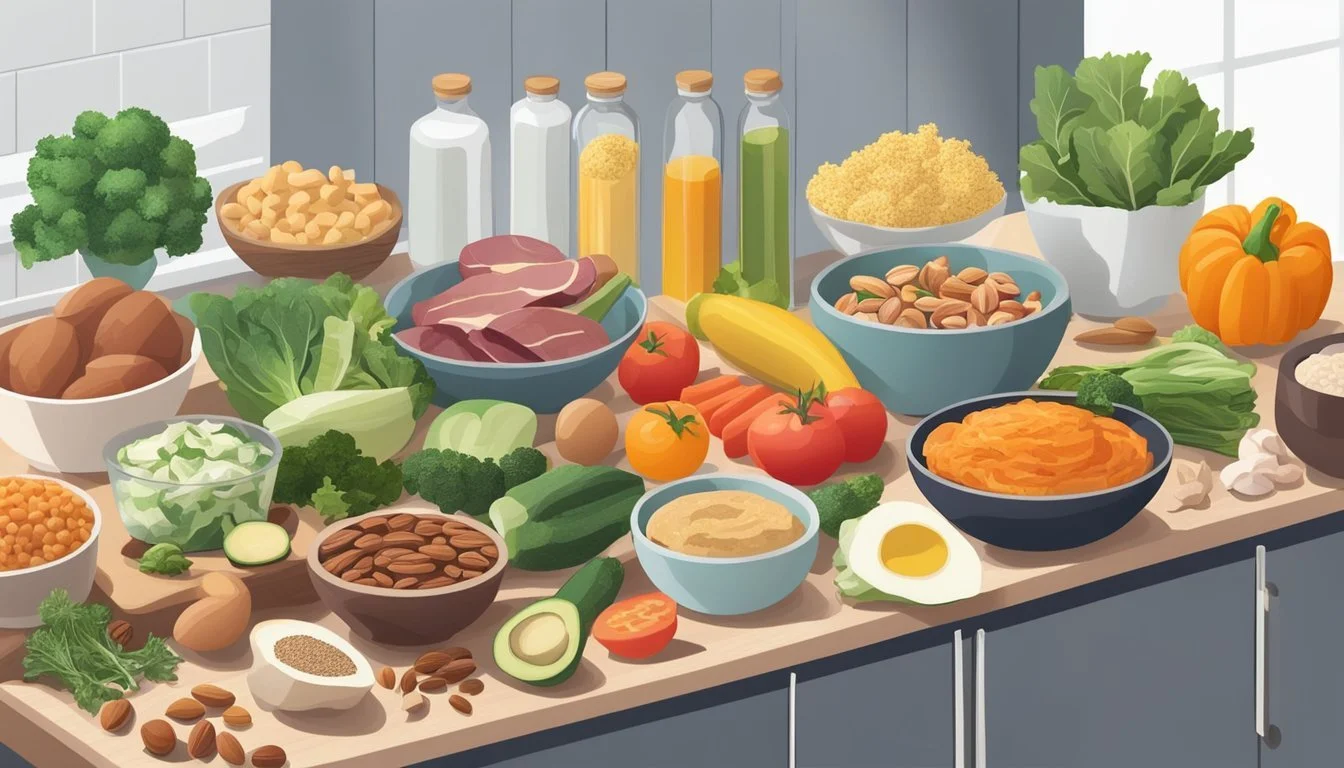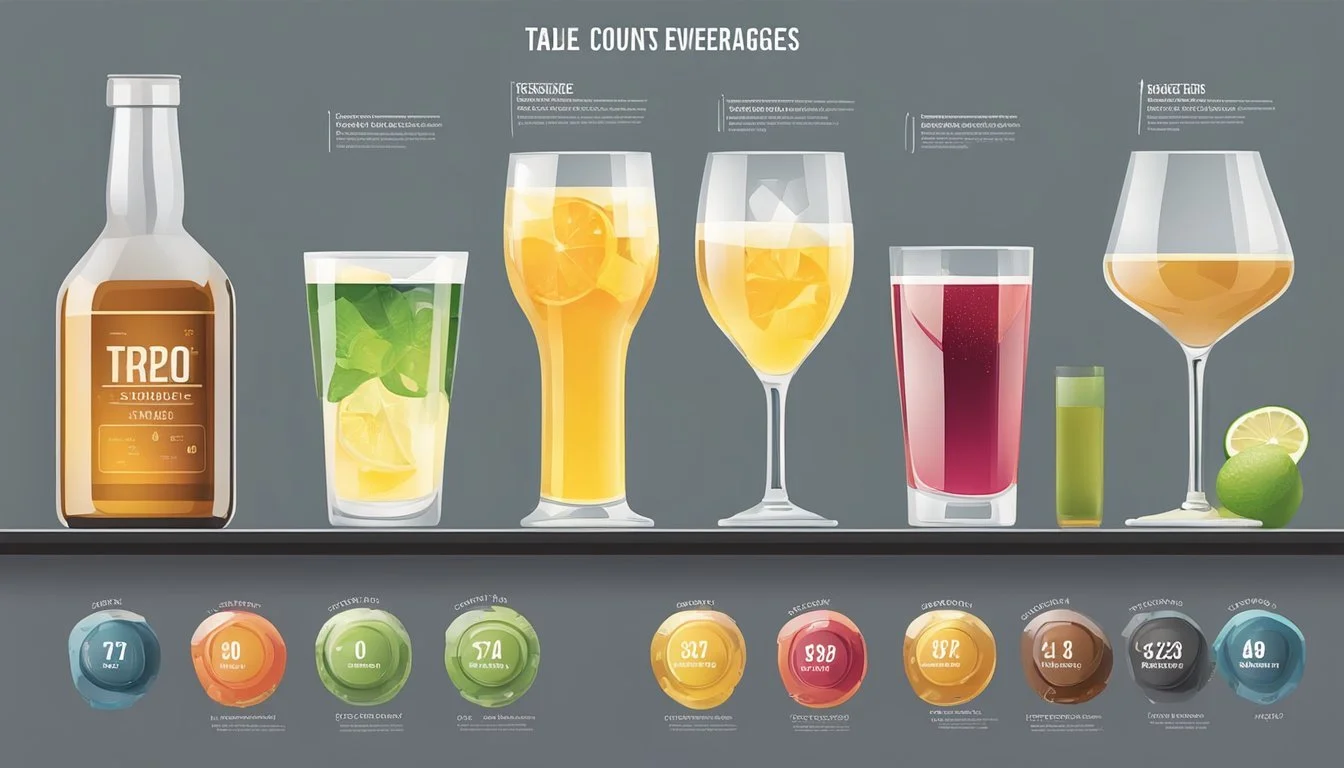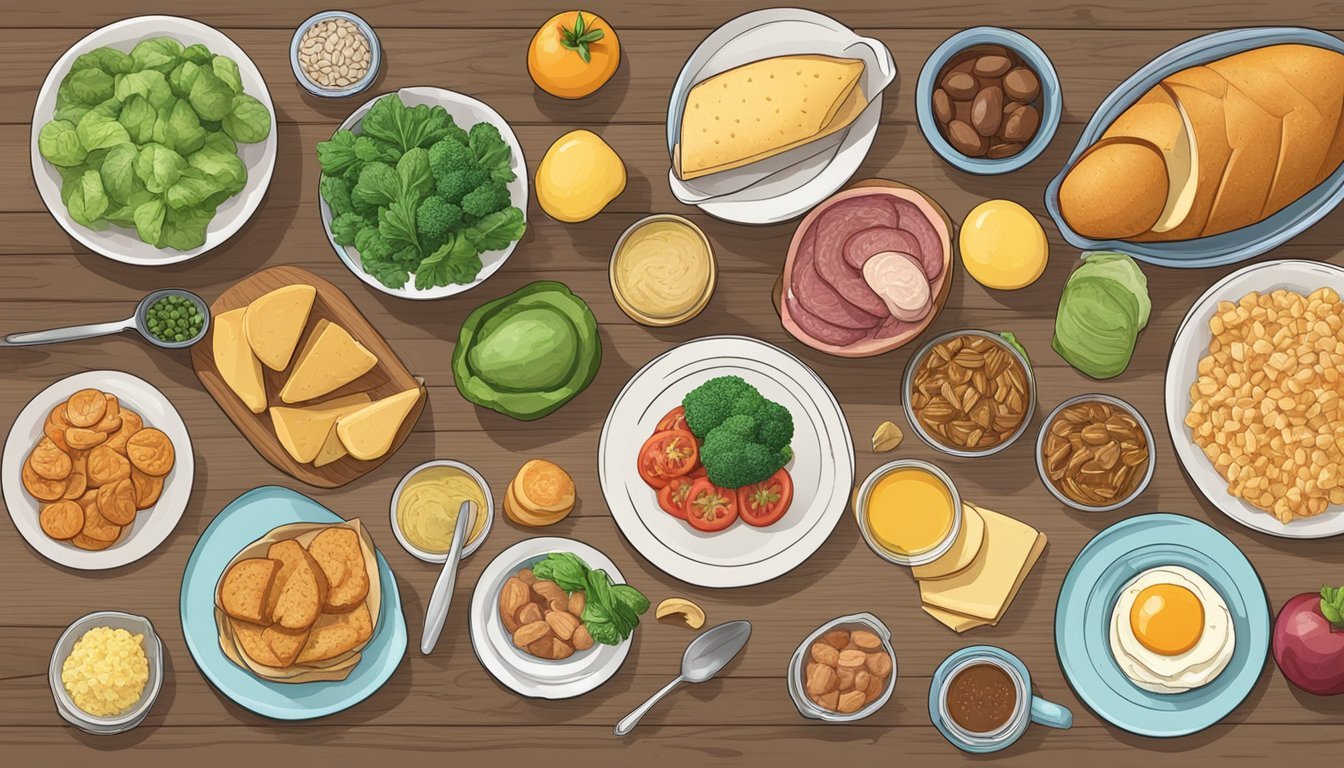Keto Diet: Hidden Carbs You Might Be Overlooking
The ketogenic diet, commonly known as the keto diet, is a nutritional regimen that emphasizes high fat intake and low carbohydrate consumption to trigger the body's natural state of ketosis. This metabolic state is characterized by the burning of fat for energy rather than carbohydrates, often leading to weight loss. For individuals on this diet, it is crucial to monitor carbohydrate intake meticulously, as exceeding a relatively small daily limit—typically around 20 to 30 grams—can prevent the body from entering or maintaining ketosis.
However, one of the challenges faced by those following a keto diet is the presence of hidden carbs. These are carbohydrates that may not be immediately apparent in foods that are considered keto-friendly or in products that are marketed as low-carb. They can be found in a variety of sources including condiments, processed meats, and dairy products. Unaccounted for, these hidden carbs can accumulate quickly and impede progress, making it difficult for dieters to achieve and sustain ketosis.
Understanding the implications of hidden carbs is paramount for maintaining the delicate balance required by the keto diet. It necessitates a careful examination of food labels, an awareness of potential sources of hidden carbs, and an appreciation for the impact these can have on the overall carbohydrate count. For keto dieters, remaining vigilant about these covert sources is a critical component of successfully adhering to the diet and leveraging its full potential for weight loss and improved metabolic health.
Understanding Keto Diet Basics
To adeptly manage a ketogenic diet, one must grasp the fundamental principles, particularly how ketosis is achieved and the pivotal role of carbohydrates.
Defining Ketosis
Ketosis is a metabolic state where the body, deprived of sufficient carbohydrates, begins to burn fat for energy, leading to the production of molecules called ketones. This state is the cornerstone of the ketogenic diet and is achieved when carbohydrate intake is drastically reduced to typically between 20 to 50 grams per day.
The Role of Carbohydrates in Keto
Carbohydrates are the body's preferred energy source, but on a ketogenic diet, their intake is minimized to encourage the body to switch to fat as an alternative fuel source. As such, maintaining a strict limit on carbohydrate consumption is critical for staying in ketosis.
Identifying Net Carbs
Calculating 'net carbs' is a key practice in a ketogenic diet. Net carbs are the total carbohydrates minus the fiber and sugar alcohols, which have a negligible effect on blood sugar levels. Recognizing net carbs assists individuals in managing their carb intake to stay within the ketosis threshold.
Total Carbs
Fiber
Sugar Alcohols = Net Carbs
This formula allows for precise tracking of daily carbohydrate consumption, ensuring one remains within the parameters that promote the maintenance of ketosis.
Hidden Carbs and How to Spot Them
This section focuses on the identification of hidden carbs, which can often disrupt a ketogenic diet. Understanding these hidden sources, accurately reading food labels, and the effect of sugar alcohols are essential for maintaining ketosis.
Common Sources of Hidden Carbs
Hidden carbs can appear in a variety of foods that one might assume are low-carb. For instance, sauces and dressings often contain sugars and thickeners which contribute additional carbohydrates. Similarly, processed meats might also be a source of hidden carbs, especially if they contain added ingredients like dextrose or other fillers. Even vegetables such as onions and tomatoes can have more carbs than one might expect.
Sauces/Dressings: Often have added sugars.
Processed Meats: May contain dextrose, breadcrumbs, or other carb-heavy fillers.
Reading Food Labels Accurately
To avoid unintentional consumption of carbs, one must become adept at reading nutrition labels. The total carbohydrate count is important, but it is just as crucial to look at the ingredients list for hidden sugars or starches. Ingredients are listed by quantity, from highest to lowest. Words like maltodextrin, sorbitol, or any other word ending in "-ose" can indicate the presence of carbohydrates.
Look for words ending in "-ose," such as fructose or glucose.
Consider both the total carbs and the order of ingredients.
The Impact of Sugar Alcohols
Sugar alcohols are commonly found in "sugar-free" or "no added sugar" products and can affect one's carb intake. Not all sugar alcohols have the same impact on blood sugar levels. For example, erythritol has little to no effect on blood sugar, while others like maltitol can have a more significant impact. Therefore, individuals following a keto diet must understand which sugar alcohols may affect ketosis.
Erythritol: Minimal impact on blood sugar.
Maltitol: May significantly affect blood sugar.
Nutritional Components of Foods
In the ketogenic diet, understanding the nutritional makeup of foods is crucial to maintaining ketosis. Key macronutrients such as fats, proteins, and fiber-rich vegetables play specific roles that must be managed strategically.
Fiber: Your Ally in Keto
Fiber is a fundamental component, especially for those on a ketogenic diet. It is a carbohydrate that the body cannot digest, so it does not raise blood sugar levels, helping maintain ketosis. Vegetables are an excellent source of dietary fiber, with leafy greens, broccoli, and cauliflower featuring prominently in keto diet plans. They provide bulk and aid in digestion without contributing to the net carb count, a crucial consideration for keto dieters.
Understanding Fats and Proteins
Fats are the cornerstone of the ketogenic diet. They should predominantly come from quality sources like avocados, olive oil, coconut oil, and butter from grass-fed cows. Nuts like almonds and macadamias also contribute healthy fats, though their carb content must be monitored.
Proteins are essential for muscle repair and maintenance but should be consumed in moderation to prevent excess glucose production through gluconeogenesis. Foods like meat, poultry, fish, and certain dairy products such as cheese and Greek yogurt are high in protein and keto-friendly. Keto dieters should choose their proteins carefully, considering the fat content and opting for unprocessed options whenever possible.
Specific Food Categories on Keto
When it comes to the keto diet, understanding which foods fit into specific categories is crucial for maintaining a state of ketosis. The focus is on low-carb and high-fat options across meats, vegetables, dairy, and beverages.
Meats and Seafood
Meats: For those on keto, meats are a staple source of protein and fat. However, it's important to choose meats that haven't been processed or added with carbs. Ideal choices include:
Beef
Pork
Lamb
Goat
Poultry like chicken is also excellent, provided it's consumed skin-on to increase fat intake.
Seafood: Most fish and shellfish (What wine goes well with shellfish?) are keto-friendly due to their low carb content. Select options rich in omega-3 fatty acids for added health benefits. Some top choices are:
Fish, such as salmon and mackerel
Shellfish like clams (What wine goes well with clams?)and mussels (What wine goes well with mussels?)
Oysters
Shrimp
Vegetables and Greens
Vegetables on the keto diet should be low in carbs but high in fiber and nutrients. Leafy greens are exceptionally well-suited for this purpose:
Kale
Spinach
Lettuce
Avocado, while technically a fruit, is also an integral part of the keto diet due to its high-fat content and minimal carbohydrates.
Dairy and Nuts
Dairy products should be chosen based on their fat content and carb count:
Cheese, especially hard and full-fat varieties
Heavy cream and sour cream are excellent for adding richness to dishes
Nuts can be included in moderation. They provide healthy fats but their carb content can add up, so portion control is key.
Drinks and Beverages
Hydration is essential on keto but not all beverages are equal:
Water is the best choice for staying hydrated without adding carbs.
Tea can also be enjoyed, preferably without any sweeteners.
Dairy-based drinks like milk can be high in carbs, so they should either be avoided or consumed minimally. When it comes to alcohol, one must be cautious as many alcoholic drinks contain hidden carbs and can disrupt ketosis.
Avoiding Hidden Carbs in Common Foods
In navigating the keto diet, it is crucial to be vigilant about hidden carbs, especially in processed foods, sauces, and snacks. These hidden sugars and starches can quickly add up and disrupt ketosis.
Processed Foods and Meats
Processed foods and meats come with convenience but often carry hidden carbs that can impede a keto diet. For instance, processed meats like bacon or deli meats might contain sugars and fillers. Checking labels is paramount, as even a small amount of added sugar can accumulate over the day.
Look For: Meats with no added sugars or starches.
Avoid: Products with ingredients like dextrose, maltodextrin, or corn syrup.
Sauces, Condiments, and Spices
Sauces, condiments, and spices enhance flavor but may harbor carbs that go unnoticed. A tablespoon of ketchup could contain nearly 4 grams of carbs, primarily from sugar. Alternative condiments like mayo or mustard might be lower in carbs but still require moderation and label scrutiny.
Choose Wisely: Mustard and mayo with no added sugars, soy sauce in moderation.
Use Caution: Balsamic vinegar and spices with added sugars like some chili powders.
Snacking Smartly on Keto
Snacking on a keto diet demands careful selection to avoid carbs. Traditional snacks like cookies should be replaced with keto-friendly alternatives. When selecting snacks, it is important to check the nutritional information to ensure they align with keto guidelines.
Best Options: Cheese, nuts, and seeds are typically safe snack choices.
Hidden Carbs: Beware of low-carb products that may include sugar alcohols or fiber which might affect blood sugar levels.
Managing Carbs While Dining Out
When adhering to a keto diet, individuals must be vigilant about carbohydrate intake, especially in restaurants where hidden carbs can disrupt ketosis. Successful dining out on keto involves strategic meal planning and a clear understanding of menu items.
Meal Planning: Before visiting a restaurant, one should review the menu online, if available, to identify low-carb options. Planning ahead can help resist starchy temptations and enable diners to navigate the menu more efficiently.
Substitutions:
Swap out bread, rice, pasta, and potatoes with low-carb vegetables or a side salad.
Instead of a burger bun, request a lettuce wrap.
Ask for more details on sauces and dressings, as they can be hidden sources of sugars and carbs.
High-carb Item Low-carb Substitution Bread - Pasta Extra Veggies Potatoes Salad Burger Bun Lettuce Wrap Sugary Sauces/Dressings Olive Oil & Vinegar
Communication with Staff: Communicate dietary preferences to the waitstaff. They may offer insights into the best keto-friendly options or accommodate special requests to remove or replace high-carbohydrate ingredients.
Recipes and Ingredients: Individuals should familiarize themselves with common ingredients and cooking methods that align with their dietary goals. By understanding how dishes are prepared, they can make informed decisions and steer clear of hidden carbs.
Navigating restaurant menus requires attention to detail and sometimes a direct dialogue with the restaurant staff, but with the right approach, diners following a keto diet can enjoy meals out without compromising their low-carb lifestyle.
Keto-Friendly Alternatives and Recipes
In the pursuit of a successful keto diet, understanding how to substitute high-carb foods with low-carb alternatives is critical. This section will guide the reader through crafting home-cooked keto recipes and choosing appropriate keto-compatible ingredients to maintain ketosis without sacrificing flavor or diversity in their meals.
Home-Cooked Keto Recipes
When replacing high-carb staples like bread, pasta, and potatoes, home-cooked recipes that utilize low-carb alternatives can be both satisfying and aligned with ketogenic principles. For example:
Bread: Alternative keto bread can be made using almond or coconut flour to significantly lower the carb content.
Pasta: Zucchini noodles (also known as zoodles) or shirataki noodles make excellent pasta substitutes, enabling the enjoyment of Italian-inspired dishes.
Potatoes: Instead of traditional mashed potatoes, try mashed cauliflower seasoned with garlic, cream, and cheese for a creamy, comforting dish.
It's essential to have a repertoire of recipes that replicate the texture and fulfill the comfort factor of their high-carb counterparts.
Choosing Keto-Compatible Ingredients
Selecting the right ingredients is fundamental when preparing keto-friendly dishes to ensure the carb count is kept to a minimum. Here are some considerations:
Starchy Vegetables and Corn: Opt for non-starchy vegetables like broccoli, spinach, and mushrooms, which are nutritious yet low in carbohydrates.
Sugar and Sweeteners: Natural sweeteners like stevia, erythritol, and monk fruit can be used in place of sugar and are much lower in carbs. Other sugar alcohols like sorbitol, maltitol, and xylitol can also be keto-friendly, but it's essential to check individual tolerance as they may affect blood sugar levels in some people. Avoid high-carb sweeteners such as agave or traditional sugar.
Ingredients for Cooking and Baking: Use healthy fats such as olive oil, coconut oil, or butter for cooking. Almond flour and coconut flour are excellent for keto baking alternatives.
By careful ingredient selection, those following the keto diet can create a diverse range of delicious, low-carb dishes.
Understanding and Counting Carbs in Alcohol
When following a ketogenic diet, it's vital to be aware of the carbohydrate content in alcoholic beverages as they can easily disrupt ketosis. Hidden sugars and carbs in certain drinks are a pitfall for many.
Alcoholic Drinks to Avoid
Individuals on a ketogenic diet should steer clear of liqueurs and flavored alcoholic drinks as they typically contain high levels of sugar and carbs. For example, cocktails mixed with soda, juice, or sweetened mixers are often laden with carbs that can halt ketosis. Beers, including those labeled as "light," generally have a considerable number of carbs and should be limited.
Cocktails with juice (e.g., margaritas, daiquiris): High in sugar.
Regular Beer: Contains 10-20g of carbs per pint.
Flavored liquors: Often contain added sugars.
Keto-Friendly Alcohol Options
To choose keto-friendly alcohol, one must opt for pure, unsweetened spirits and certain low-carb wines and beers. Spirits like vodka, rum, gin, tequila, and whiskey have 0g net carbs when unflavored. Meanwhile, for wine enthusiasts, dry wines are preferable as they contain minimal sugars.
Spirits (Unflavored and unsweetened): Vodka, rum, gin, tequila, whiskey.
Dry Wines: Low sugar content.
Low-Carb Beers: Some options are available with 2-5g of carbs per serving.
It is crucial to consume these drinks in moderation and be mindful of serving sizes to stay within the daily carb allowance for a keto diet.
Long-Term Keto Diet Considerations
When considering a ketogenic diet for an extended period, one must carefully evaluate how to maintain nutritional balance and understand potential health impacts. Ensuring that the diet does not compromise long-term health is paramount.
Maintaining Nutritional Balance
Adherents of the ketogenic diet must prioritize obtaining a complete range of nutrients while restricting their carbohydrate intake. The diet typically involves a high intake of fats and adequate protein levels. Individuals must choose nutrient-dense foods to prevent deficiencies that can arise when entire food groups are limited. Nutritional balance is particularly important as weight loss progresses, to support overall health and bodily functions, including those of the liver and kidneys.
Fats: Select high-quality fats from sources like avocados, nuts, and seeds.
Proteins: Opt for lean meats, fish, and plant-based proteins that do not carry hidden carbs.
Micronutrients: A diverse intake of leafy greens and low-carb vegetables helps maintain vitamin and mineral levels.
Potential Health Impacts
The ketogenic diet's long-term health effects are a topic of ongoing research. While many individuals experience significant weight loss and improved blood sugar levels, there can be potential risks. Prolonged adherence to such a restrictive diet may pose challenges to kidney and liver health due to the increased workload from processing fat and protein.
Blood Sugar Levels: For those with diabetes, close monitoring is essential to avoid hypoglycemia due to low carbohydrate consumption.
Kidney Health: High protein intake can strain kidneys over time, so those with preexisting kidney conditions should approach the diet with caution.
Liver Health: The metabolism of high fat may increase the workload on the liver, necessitating regular monitoring.
By following these guidelines, individuals can approach the ketogenic diet with an informed perspective that prioritizes their long-term health and nutritional well-being.
Supplements and Keto Lifestyle
When an individual commits to a ketogenic diet, they focus on consuming foods high in fat, moderate in protein, and very low in carbohydrates. Essential vitamins and minerals might be reduced due to the exclusion of certain food groups. As such, supplements can play a key role in the keto lifestyle to ensure that nutritional needs are met.
Magnesium: It's common for those on a low-carb diet to need magnesium supplementation due to less water retention, which can deplete magnesium levels. A lack of magnesium may lead to muscle cramps, difficulty sleeping, and irritability.
Fiber: Reduced carbohydrate intake can lead to a lack of fiber. One might consider a fiber supplement or ensure that low-carb, high-fiber foods such as chia seeds or flaxseeds are included in their meals.
Vitamins and Minerals: A well-formulated keto diet should include a variety of nutrients. However, to fill any potential gaps, a multivitamin may be beneficial. This is particularly true for B vitamins, vitamin D, and selenium, which can sometimes be hard to obtain in adequate amounts on a strict keto diet.
Electrolytes: Sodium, potassium, and other electrolytes are often excreted at a higher rate on a keto diet. An electrolyte supplement can help maintain a balance, preventing symptoms like headaches, fatigue, and cramping.
In summary, individuals should assess their diet, preferably with a healthcare provider, to determine which, if any, supplements may support their health goals and keto lifestyle. Each person's needs can vary, so personalized advice is optimal.
Keto Diet Myths and Misconceptions
The Ketogenic diet is a high-fat, low-carbohydrate regimen often misunderstood in terms of its relationship with fats and carbs. Here are common myths and misconceptions:
Myth 1: Eating more fat will automatically lead to higher fat burn.
Fact: It is the state of ketosis that aids in fat metabolism, not just the intake of fats.
Myth 2: Eating fat is the key to feeling satiated.
Fact: While fats can be satisfying, balance and portion size matter.
Myth 3: Dietary fat has free reign on a Keto diet.
Fact: Calories still count; excess dietary fat can lead to weight gain.
Myth 4: Carbohydrate allowance is the only concern.
Misconception: Hidden carbs in foods like nuts must be accounted for to maintain ketosis.
Blood sugar levels are affected by carb intake, making it crucial for individuals to monitor food choices. Even low-carb foods can accumulate to significant levels, potentially disrupting ketosis and impacting blood sugar. It's imperative to recognize the facts to navigate the ketogenic diet effectively. Understanding these myths ensures a well-informed approach to keto and helps manage expectations regarding weight loss and health benefits.
Conclusion
Adhering to a ketogenic diet often requires vigilance against hidden carbohydrates to ensure one remains in a state of ketosis. The presence of such carbs can unintentionally disrupt an individual's progress, potentially stalling weight loss efforts or affecting the state of ketosis. Individuals must scrutinize food labels and be aware of hidden carbs in everyday items, from meats to sauces.
For long-term success on the keto diet, one may need to embrace significant lifestyle changes. These include embracing whole, unprocessed foods high in fat and low in carbohydrates, consistent monitoring of macronutrient intake, and possibly restructuring one's approach to cooking and meal planning.
Health benefits of a ketogenic diet have been reported, particularly in terms of weight loss and improved blood sugar control. However, these benefits must be weighed against potential side effects, especially during the initial phase of the diet. Frequently, these symptoms subside as the body adjusts to a new fuel source.
In conclusion, lifestyle changes are fundamental for maintaining the strict balance required for a ketogenic diet. As every individual reacts differently, it's crucial to align the diet with personal health goals under professional guidance to avoid nutritional deficiencies and ensure well-being.






